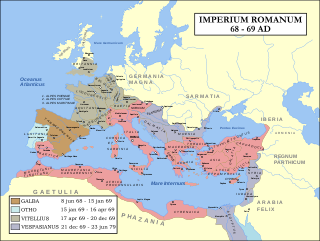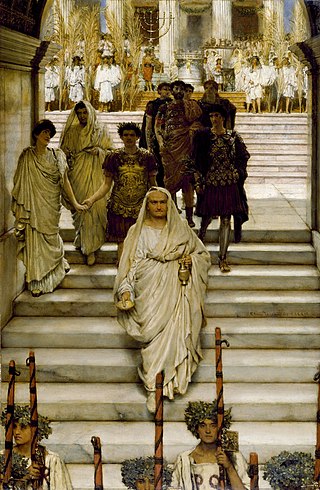
Vespasian was Roman emperor from 69 to 79. The last emperor to reign in the Year of the Four Emperors, he founded the Flavian dynasty, which ruled the Empire for 27 years. His fiscal reforms and consolidation of the empire brought political stability and a vast building program.

The 1st century was the century spanning AD 1 through AD 100 (C) according to the Julian calendar. It is often written as the 1st century AD or 1st century CE to distinguish it from the 1st century BC which preceded it. The 1st century is considered part of the Classical era, epoch, or historical period. The Roman Empire, Han China and the Parthian Persia were the most powerful and hegemonic states.

AD 69 (LXIX) was a common year starting on Sunday of the Julian calendar. In the Roman Empire, it was known as the Year of the consulship of Galba and Vinius. The denomination AD 69 for this year has been used since the early medieval period, when the Anno Domini calendar era became the prevalent method in Europe for naming years.
AD 43 (XLIII) was a common year starting on Tuesday of the Julian calendar. At the time, it was known as the Year of the Consulship of Caesar and Vitellius. The denomination AD 43 for this year has been used since the early medieval period, when the Anno Domini calendar era became the prevalent method in Europe for naming years.

AD 79 (LXXIX) was a common year starting on Friday of the Julian calendar. At the time, it was known as the Year of the Consulship of Titus and Vespasianus. The denomination AD 79 for this year has been used since the early medieval period, when the Anno Domini calendar era became the prevalent method in Europe for naming years.

The 60s decade ran from January 1, AD 60, to December 31, AD 69.

The 70s was a decade that ran from January 1, AD 70, to December 31, AD 79.
AD 9 (IX) was a common year starting on Tuesday of the Julian calendar. In the Roman Empire, it was known as the Year of the Consulship of Sabinus and Camerinus. The denomination "AD 9" for this year has been used since the late medieval period, when the Anno Domini calendar era became the prevalent method in Europe for naming years.
AD 70 (LXX) was a common year starting on Monday of the Julian calendar. At the time, it was known as the Year of the Consulship of Vespasian and Titus. The denomination AD 70 for this year has been used since the early medieval period, when the Anno Domini calendar era became the prevalent method in Europe for naming years.
AD 67 (LXVII) was a common year starting on Thursday of the Julian calendar. At the time it was known as the Year of the Consulship of Julius Rufus and Fonteius Capito. The denomination AD 67 for this year has been used since the early medieval period, when the Anno Domini calendar era became the prevalent method in Europe for naming years.
AD 71 (LXXI) was a common year starting on Tuesday of the Julian calendar. At the time, it was known as the Year of the Consulship of Vespasian and Nerva. The denomination AD 71 for this year has been used since the early medieval period, when the Anno Domini calendar era became the prevalent method in Europe for naming years.
AD 72 (LXXII) was a leap year starting on Wednesday of the Julian calendar. At the time, it was known as the Year of the Consulship of Vespasian and Titus. The denomination AD 72 for this year has been used since the early medieval period, when the Anno Domini calendar era became the prevalent method in Europe for naming years.

AD 73 (LXXIII) was a common year starting on Friday of the Julian calendar. At the time, it was known as the Year of the Consulship of Domitian and Messalinus. The denomination AD 73 for this year has been used since the early medieval period, when the Anno Domini calendar era became the prevalent method in Europe for naming years.
AD 74 (LXXIV) was a common year starting on Saturday of the Julian calendar. At the time, it was known as the Year of the Consulship of Titus and Vespasian . The denomination AD 74 for this year has been used since the early medieval period, when the Anno Domini calendar era became the prevalent method in Europe for naming years.
AD 75 (LXXV) was a common year starting on Sunday of the Julian calendar. At the time, it was known as the Year of the Consulship of Augustus and Vespasianus. The denomination AD 75 for this year has been used since the early medieval period, when the Anno Domini calendar era became the prevalent method in Europe for naming years.

Titus Caesar Vespasianus was Roman emperor from 79 to 81. A member of the Flavian dynasty, Titus succeeded his father Vespasian upon his death.

The Flavian dynasty ruled the Roman Empire between AD 69 and 96, encompassing the reigns of Vespasian (69–79), and his two sons Titus (79–81) and Domitian (81–96). The Flavians rose to power during the civil war of 69, known as the Year of the Four Emperors. After Galba and Otho died in quick succession, Vitellius became emperor in mid 69. His claim to the throne was quickly challenged by legions stationed in the eastern provinces, who declared their commander Vespasian emperor in his place. The Second Battle of Bedriacum tilted the balance decisively in favour of the Flavian forces, who entered Rome on 20 December. The following day, the Roman Senate officially declared Vespasian emperor of the Roman Empire, thus commencing the Flavian dynasty. Although the dynasty proved to be short-lived, several significant historic, economic and military events took place during their reign.
An indiction was a periodic reassessment of taxation in the Roman Empire which took place every fifteen years. In Late Antiquity, this 15-year cycle began to be used to date documents and it continued to be used for this purpose in Medieval Europe, and can also refer to an individual year in the cycle; for example, "the fourth indiction" came to mean the fourth year of the current indiction. Since the cycles themselves were not numbered, other information is needed to identify the specific year.

Legio VII Claudia was a legion of the Imperial Roman army.









